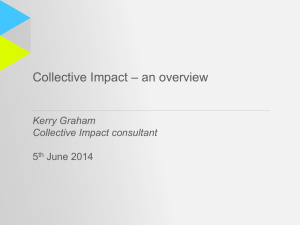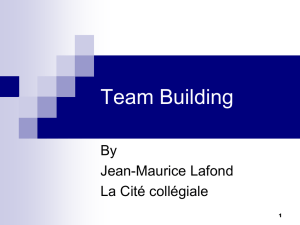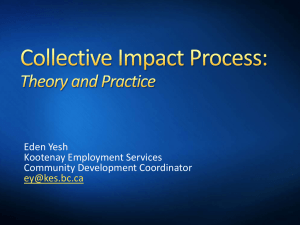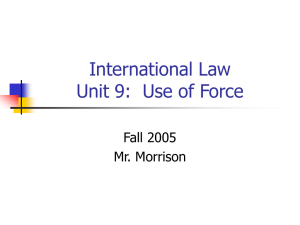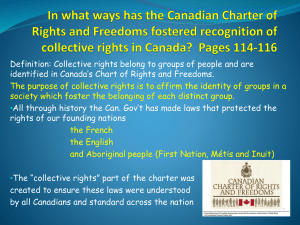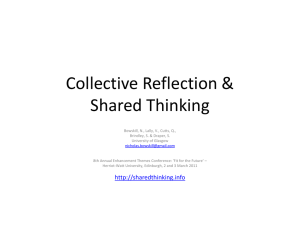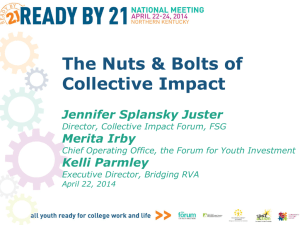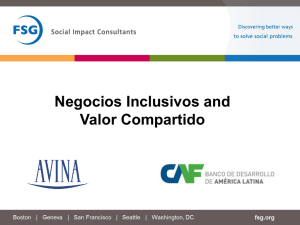Adelaide – Getting Ready for Collective Impact
advertisement
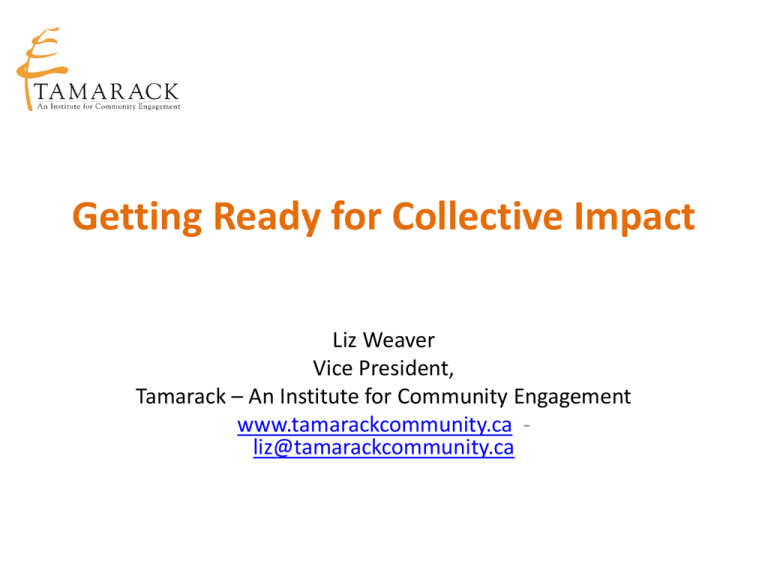
Getting Ready for Collective Impact Liz Weaver Vice President, Tamarack – An Institute for Community Engagement www.tamarackcommunity.ca liz@tamarackcommunity.ca About Tamarack – An Institute for Community Engagement Tamarack is a charity that develops and supports learning communities that helps people to collaborate, co-generate knowledge and achieve collective impact on complex community issues. Our vision is to build a connected force for community change. Join us as we discover how communities can act together for positive change! Visit our websites: • www.tamarackcommunity.ca • www.seekingcommunity.ca • www.vibrantcommunities.ca • www.tamarackcci.ca 2 Workshop Overview • • • • • The Context: Collaboration and Complexity The Framework: Collective Impact The Issue: The Community Context The Challenge: Working Differently The Case: Human and Financial Investments The Context The Collaboration Spectrum Trust Compete Co-exist Communicate Cooperate Coordinate Collaborate Competition for clients, resources, partners, public attention. No systematic connection between agencies. Inter-agency information sharing (e.g. networking). As needed, often informal, interaction, on discrete activities or projects. Organizatio ns systematical ly adjust and align work with each other for greater outcomes. Longer term interaction based on shared mission, goals; shared decisionmakers and resources. Integrate Fully integrated programs, planning, funding. Turf Loose Tight 5 Table Discussion: Collaboration Spectrum How could you use the Collaboration Spectrum with your community partners and with current collaborative efforts? Complexity + Community Change Learn-by-doing, see what emerges, adapt. Develop common ground, compromise or compete. Follow the ‘best practice’ recipe. Wicked Problems & Social Messes Use expertise, experiment and build knowledge. Create stability, look for opportunities to innovate. Characteristics of Complex Problems Complex problems are difficult to frame The cause and effect relationships are unclear There are diverse stakeholders Each experience of is unique The characteristics & dynamics of the issue evolves There is no obvious right or wrong set of solutions There is no objective measure of success Managing Complex Problems TRADITIONAL RESPONSE CHARACTERISTICS OF COMPLEX ISSUES ADAPTIVE RESPONSE Specialization Multiple Root Causes Orchestration Silos Multiple Stakeholders Cross Boundary Crisp Problem Definition Difficult to Frame Working Framework Plan the Work, Work the Plan Emergent Act, React and Adapt Resolve Paradoxes & Dilemmas Cope Standardized and Detailed Blueprint Unique Minimum Specs, Variation & Customization Short Term Intractable Long Term Collective Impact An Overview of Collective Impact Greater Cincinnati Foundation Collective Impact: Pulling Together http://www.youtube.com/watch?v=1ZZRvNXOozc From Isolated Impact to Collective Impact Isolated Impact Collective Impact • Funders select individual grantees • • Organizations work separately Funders understand that social problems – and their solutions – arise from multiple interacting factors • Evaluation attempts to isolate a particular organization’s impact • • Large scale change is assumed to depend on scaling organizations Cross-sector alignment with government, nonprofit, philanthropic and corporate sectors as partners • Corporate and government sectors are often disconnected from foundations and non-profits. Organizations actively coordinating their actions and sharing lessons learned • All working toward the same goal and measuring the same things • 14 Collective Impact is… …positive and consistent progress at scale. - John Kania, FSG Social Impact Consultants, Oregon 2013 15 Used for Many Complex Issues Teen Pregnancy Homelessness Health Community Safety Education Poverty Collective Impact – Framing Questions • Do we aim to effect ―needle- change (i.e., 10% or more) on a community-wide metric? • Do we believe that a long-term investment (i.e., three to fiveplus years) by stakeholders is necessary to achieve success? • Do we believe that cross-sector engagement is essential for community-wide change? • Are we committed to using measurable data to set the agenda and improve over time? • Are we committed to having community members as partners and producers of impact? Phases of Collective Impact The Phases of Collective Impact Components for Success Phase I Generate Ideas and Dialogue Phase II Initiate Action Governance Convene community Identify champions and form crossand stakeholders sector group Infrastructure Phase III Organize for Impact Phase IV Sustain Action and Impact Create infrastructure (backbone and processes) Facilitate and refine Strategic Planning Hold dialogue about Map the landscape Create common issue, community and use data to agenda (common context, and make case goals and strategy) available resources Support implementation (alignment to goal and strategies) Community Involvement Facilitate community outreach specific to goal Determine if there is Evaluation consensus/urgency And Improvement to move forward Facilitate community outreach Engage community and build public will Continue engagement and conduct advocacy Analyze baseline data to ID key issues and gaps Establish shared metrics (indicators, measurement, and approach) Collect, track, and report progress (process to learn and improve) Preconditions for Collective Impact • Influential Champion(s) • Urgency of issue • Adequate Resources The Five Conditions of Collective Impact Common Agenda Shared Measurement Mutually Reinforcing Activities Continuous Communication Backbone Support All participants have a shared vision for change including a common understanding of the problem and a joint approach to solving it through agreed upon actions Collecting data and measuring results consistently across all participants ensures efforts remain aligned and participants hold each other accountable Participant activities must be differentiated while still being coordinated through a mutually reinforcing plan of action Consistent and open communication is needed across the many players to build trust, assure mutual objectives, and appreciate common motivation Creating and managing collective impact requires a dedicated staff and a specific set of skills to serve as the backbone for the entire initiative and coordinate participating organizations and agencies Source: FSG 11 The Issue Common Agenda • Define the challenge to be addressed. • Acknowledge that a collective impact approach is required. • Establish clear and shared goal(s) for change. • Identify principles to guide joint work together. Building a Common Agenda Prior History Positive or negative impact Pressing Issue Galvanize leaders across sectors Data Determine what you need to understand impact of the issue on community Community Context Is there community buy in? Determine community leverage opportunities Core Group Determine who needs to be involved in core group Convener Trusted leadership to facilitate collaborative efforts Community Engagement Determine how to engage the broader community in the effort Where is your community? • Waiting place – waiting for something to create a pivot point • Impasse – know there is a problem, but it’s someone else’s problem • Catalytic – gearing up for change • Growth – engaging citizens in change • Renewal and sustaining • Source: The Harwood Institute Common Agenda What makes the difference between a good movie and a bad movie? “Getting everyone involved to make the same movie!” - Francis Ford Coppola 25 The Community Context What are the key community context elements we need to consider to work collectively in Adelaide? Common Agenda Exercise: Theory of Change Tool Strategies Assumptions 6 5 Influential Factors Problem or Issue 1 4 Desired results (outputs, outcomes and impact) 3 Community needs/assets 2 Source: Kellogg Foundation, 2004 The Challenge: Work Differently Highly Effective Communities 1. Reach for It 2. Go with who you’ve got 3. Hold the centre 4. Keep the circle open 5. Avoid the blame game 6. Choose measureable outcomes 7. Develop a sense of urgency and keep going Shared Measurement • Identify key measures that capture critical outcomes. • Establish systems for gathering and analyzing measures. • Create opportunities for “making-sense” of changes in indicators. Thinking About Shared Measurement Process: # of people/orgs at table, # of community presentations, articles, etc Progress: # of programs, # of new initiatives, etc Shared Measurement Policy: policy changes in own or other organizations, new investments, gov. policy changes Population : # of people moved out of poverty, # of high school graduates, # of low birth weight babies Thinking About Shared Measurement • Use your Theory of Change Tool as background • Brainstorm what it would take to show that your collaborative was making progress on your issue or problem. • Use the attached grid to determine where your shared measurements fit • What do you observe? Mutually Reinforcing Activities • Agreement on key outcomes. • Orchestration and specialization. • Complementary – sometimes “joined up” - strategies to achieve outcomes. Memphis Fast Forward Coordination in Saint John Poverty • • • • • • Housing Transportation Education to Employment Early Childhood Development Workforce Development Neighborhood Renewal Continuous Communication • Create formal and informal measures for keeping people informed • Communication is open and reflect a diversity of styles • Difficult issues are surfaced, discussed and addressed In and Out Communication Building the Case Backbone Organization(s) • Guide vision & strategy • Support aligned activities • Established shared measurements • Build public will • Advance policy • Mobilize funding • Like a manager at a construction site who attends to the whole building while carpenters, plumbers and electricians come and go, the support staff keep the collaborative process moving along, even as the participants may change. Jay Conner. 2004. Community Visions, Community Solutions: Grantmaking for Comprehensive Impact Backbone Organizations Common Misperceptions about the Role of Backbone Organizations Common Misperceptions • The backbone organization sets the agenda for the group • The backbone organization drives the solutions • The backbone organization receives all the funding • The role of backbone can be self appointed rather than selected by the community • The role of backbone isn’t fundamentally different from “business as usual” in terms of staffing, time, and resources Source: FSG Interviews and Analysis What will it Take? Things to Consider in Collective Impact • Patient capital • Persistence for longer term, systems change • Align funders across sectors to common agenda • Legitimize the work of the collaborative table • No playbook, support and advance the skills and capacity of collaborative partners Collective Impact • Use collective impact as a framing tool • Assess whether everyone in the collaborative is working on the same agenda • Developing success measures (process and outcome indicators) • Learn about what’s working and let go of those things that are not making an impact Reflecting on Collective Impact Think – Pair – Share • What have I learned that I can apply to my collaborative partnerships? • What other questions do I have? Tamarack Learning Opportunities www.tamarackcommunity.ca Learn together through: • • • • • Monthly tele-learning Seminars Engage! e-magazine Face-to-Face Learning Events Online Learning Communities Communities of Practice Tamarack Learning Communities Tamarack CCI For Collaborative Leaders who use collective impact approaches to address complex community issues. www.tamarackcci.ca Vibrant Communities: Cities Reducing Poverty For Cities that develop and implement comprehensive poverty reduction strategies www.vibrantcanada.ca Seeking Community For individuals who care about community, the vibrancy of neighbourhoods and the unique role of citizens in social change. www.seekingcommunity.ca Deepening Community – Just Released! Read the latest book by Paul Born President of Tamarack Institute If you do, here are some fun ways to get involved in the Deepening Community campaign: Read the book & post a short review on Amazon.com, Amazon.ca, Indigo.ca, GoodReads.com or iBook Go to the “Get Involved” page on www.deepeningcommunity.org Write a post about your thoughts/ideas on the book or on your experiences of community at www.seekingcommunity.ca Wishing you joy as you deepen community! Upcoming Tamarack Learning Events Learn more & register: http://tamarackcommunity.ca/events.html Additional Resources • Follow my blog: http://vibrantcanada.ca/blogs/liz-weaver • Regular updates about Collaboration and Collective Impact are posted on Tamarack Learning Communities Sites: www.tamarackcci.ca; www.vibrantcommunities.ca; www.seekingcommunity.ca • Stanford Social Innovation Review articles on Collective Impact: http://www.ssireview.org/ • FSG Social Impact Consultants: www.fsg.org • Collective Impact Forum: http://www.collectiveimpactforum.org/ Additional Resources on Collective Impact • FSG – collective impact resources http://www.fsg.org/KnowledgeExchange/FSGApp roach/CollectiveImpact.aspx • Resources for Backbones http://tamarackcci.ca/blogs/sylviacheuy/champions-change-leading-backboneorganization-collective-impact • Rural Communities Resources http://www.penquis.org/?id=2&sub_id=2941

